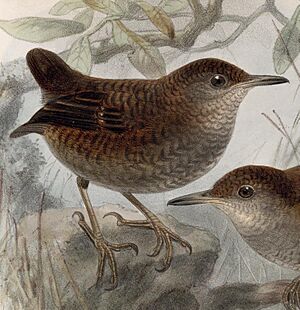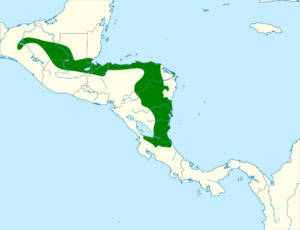Northern nightingale-wren facts for kids
Quick facts for kids Northern nightingale-wren |
|
|---|---|
 |
|
| Conservation status | |
| Scientific classification | |
| Genus: |
Microcerculus
|
| Species: |
philomela
|
 |
|
The northern nightingale-wren (Microcerculus philomela), also called the nightingale wren, is a small passerine bird. This means it's a perching bird, like many common backyard birds. It belongs to the Troglodytidae family, which includes wrens. You can find this bird in parts of Central America, including Belize, Costa Rica, Guatemala, Honduras, Mexico, and Nicaragua.
Contents
About the Northern Nightingale-Wren
What Makes This Bird Special?
The northern nightingale-wren is very similar to the southern nightingale-wren. In the past, some scientists thought they were the same species. However, most experts now agree they are two different species. This bird is considered "monotypic," meaning it's the only species in its group without any subspecies.
How to Spot a Northern Nightingale-Wren
This bird is about 10 to 11.5 centimeters (4 to 4.5 inches) long. That's about the length of an adult's hand. Males usually weigh between 17.4 and 21.5 grams (about 0.6 to 0.75 ounces). Females are a bit lighter, weighing 16.4 to 17.4 grams (about 0.58 to 0.61 ounces).
Adult northern nightingale-wrens are mostly dark brown. Their throat and chest are a dark gray color. The tips of their feathers, both on their back and belly, are black. This gives them a cool, scaly or "scalloped" look. Young birds look similar, but the scales on their upper parts are darker. The scales on their undersides are whitish or light gray.
Where Do These Birds Live?
The northern nightingale-wren lives in a wide area of Central America. You can find them from Chiapas in Mexico, through Guatemala, southern Belize, Honduras, and Nicaragua, all the way to northern Costa Rica.
They mostly live on the Atlantic side of these countries. However, you might also find them in some places on the Pacific side, like in Chiapas and Costa Rica. In Mexico, they live from areas near sea level up to about 1,400 meters (4,600 feet) high. In Costa Rica, they usually stay below 1,200 meters (3,900 feet), but sometimes go higher.
These birds prefer to live deep inside lowland tropical forest. They especially like untouched evergreen forests and undisturbed cloud forests. Cloud forests are misty, high-altitude forests where clouds often cover the trees.
Northern Nightingale-Wren Behavior
What Do They Eat?
The northern nightingale-wren looks for food on or near the ground. They search in thick bushes, piles of branches, and on fallen logs. They mostly eat insects. Sometimes, they follow groups of army ants. These ants move in large swarms and stir up insects, making it easier for the wrens to find a meal.
Reproduction and Life Cycle
Not much is known about how northern nightingale-wrens build their nests or raise their young. Reports suggest they breed between May and September in Costa Rica.
Their Unique Song
The northern nightingale-wren has a special song. It's described as a "confident to hesitant, rising and falling series of whistles." They sing this song for most of the year. You can often hear them singing from low branches in the forest.
Conservation Status
The IUCN (International Union for Conservation of Nature) has listed the northern nightingale-wren as a species of "Least Concern." This means they are not currently in danger of disappearing.
However, these birds prefer forests that have not been disturbed by humans. Because of this, they are considered to be at risk in many parts of their home range. Forests are being cleared and broken up into smaller pieces for farming. This loss of their natural home is the biggest threat to the northern nightingale-wren.


